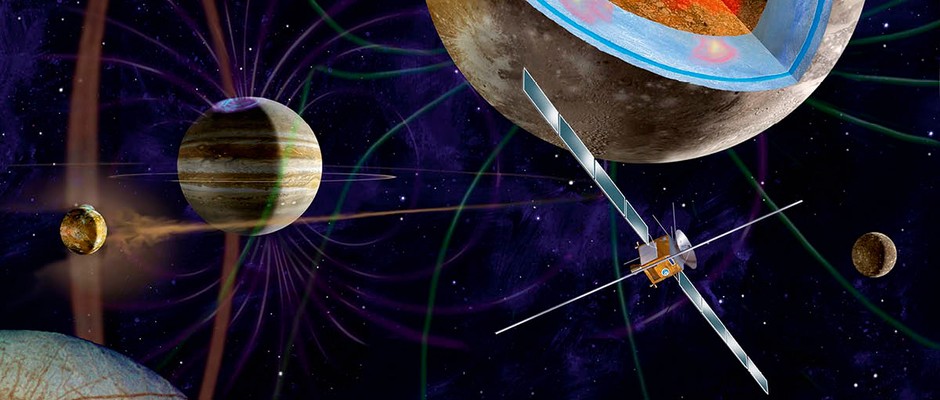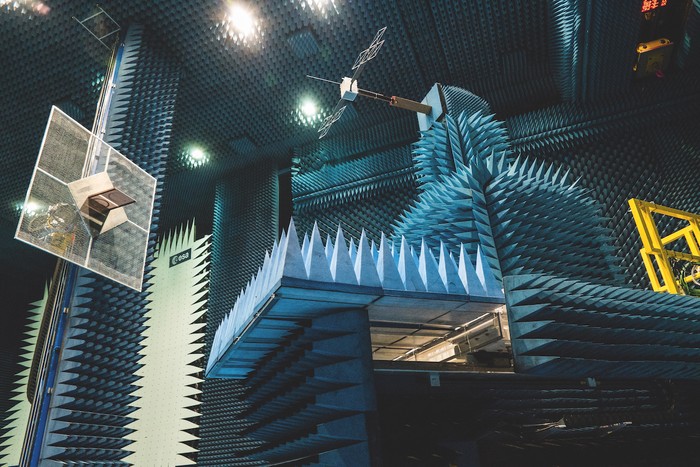
JUICE: What secrets lie beneath the icy surface of Jupiter’s moons?
The European Space Agency’s JUICE mission aims to peer beneath the surfaces of Jupiter’s moons to determine whether something could be living in the waters below.
Deep beneath the salty ocean, the seafloor is cracked. Hot gases from the layers below bubble into the water, sustaining colonies of microbial life that are eking out an existence far from the sunkissed surface.
This may sound like a scene from the bottom of Earth’s vast oceans, but it’s actually a possible description of Europa – one of the icy moons orbiting Jupiter. And thanks to the upcoming Jupiter Icy Moons Explorer (JUICE) mission, we may finally have the opportunity to find out how accurate that description is.
Astrobiologists – scientists who look for signs of life beyond the confines of our planet – have long adhered to a simple mantra: follow the water. That’s because every living thing on Earth, from the tiniest bacterium to the mighty blue whale, needs liquid water to survive. While alien life without water may be possible, looking for that molecular marriage between hydrogen and oxygen is an excellent place to start.
In the hunt for H₂O, much has been made of the habitable zone – the narrow ring around a star where the temperature is just right for liquid water. Earth sits in this region, so the majority of our water neither freezes nor boils. But the habitable zone is an imperfect concept.
“At least five objects in the outer Solar System have sub-surface oceans,” says Dr Mark Fox-Powell, an astrobiologist at the Open University. All are far beyond the outer reaches of the traditional habitable zone. Three of these oceans can be found beneath the surfaces on a trio of Jupiter’s moons: Europa, Ganymede and Callisto. Jupiter has a habitable zone of its own. The required heat isn’t coming from the Sun, but from the gravity of Jupiter. It expands and contracts the moons, warming them up like squash balls.

While we have been to the Jovian system many times, these moons have rarely been the main attraction. “The last time we were there studying them directly was with the Galileo spacecraft in the 1990s,” says Fox-Powell. Instead, the focus has tended to fall on the giant planet itself. But now there’s JUICE, a dedicated mission heading for its icy satellites.
Read more about Jupiter:
- Mystery of Jupiter’s polar cyclones solved using ocean physics
- NASA’s Juno spacecraft probes the depths of Jupiter’s Great Red Spot
- NASA's Lucy Mission is set to head to Jupiter's Trojan asteroids
The spacecraft
At the heart of the JUICE mission is a spacecraft that’s been built by the European Space Agency (ESA). It bears a slight resemblance to a giant bird, with solar panel wings stretching out on either side of the spacecraft’s main body. The sunlight at Jupiter is 30 times dimmer than the light that reaches Earth, so the panels need to be big. They cover an area equal to 85m², or about half the size of a volleyball court.
Its three-metre-diameter antenna will send the data JUICE collects back to mission control, although it will take almost two hours to travel the more than half a billion kilometres to Earth.

ESA had been working towards launching JUICE in 2022 until the coronavirus pandemic hit. Instead of the planned liftoff, this coming year will now see frantic activity as ESA scrambles to claw back the time lost during lockdown, and make the final preparations needed to ready the landmark mission for its rescheduled launch in 2023.
More like this
The original plan was for JUICE to take a convoluted route, involving five flybys of Earth, Venus and Mars to use the planets’ gravitational might to slingshot the spacecraft towards Jupiter, a journey that was set to take 7.5 years. ESA has yet to reveal exact details of the new timeline, but JUICE should arrive at Jupiter at the start of the 2030s. Once there, it will spend at least three years exploring Europa, Ganymede and Callisto. It will be joined by NASA’s Europa Clipper mission, currently scheduled for launch in 2024 and arrival in April 2030.
The moons of Jupiter
We’ve known about these moons for a long time. Along with Io – the most volcanically active place in the Solar System – Europa, Ganymede and Callisto make up the so-called ‘Galilean moons’, first seen by the Italian astronomer Galileo at the start of the 17th Century.
Of the trio that JUICE will focus on, Europa tends to steal the limelight. “It’s definitely the poster child of the Galilean moons,” says Fox-Powell. That’s because beneath its icy crust sits an ocean that contains more liquid water than all of Earth’s seas, lakes and rivers combined. If there’s life swimming around in our oceans, could the same be true of Europa?
Part of the problem is that the ocean is hiding beneath a thick, icy surface. “We can’t access it directly,” says Fox-Powell. Thankfully, scientists think the icy crust and the water are interacting, a bit like the molten rock beneath Earth’s surface that breaks through during volcanic activity. “It means we can use material on the surface to study the oceans indirectly,” Fox-Powell says.

We may even be able to collect a sample of that material, despite JUICE being unable to land on Europa. The spacecraft is carrying 10 high-precision instruments to Jupiter, including the Particle Environment Package (PEP). “It’s designed to study dust and other molecules that have been kicked up from the surface,” says Fox-Powell. “It’s not impossible that, if that material came from the oceans, it could contain molecules that are indicative of life.”
If there are organisms in Europa’s oceans, then they’ll need a source of energy. Hidden beneath the icy crust, they can’t get that energy from the Sun. Fox-Powell sees two potential options. The Jovian system is an environment flooded with intense levels of radiation as Jupiter’s magnetic field slings and funnels high-energy particles around.
“Any ocean material that ends up on the surface is going to be irradiated,” Fox-Powell says. That changes the chemistry of the ice. One likely scenario is that the radiation is breaking water into hydrogen and oxygen, with that oxygen potentially seeping back down into the ocean below. Other potential by-products include compounds containing the element sulphur. “On Earth, they’re known to support microbial life,” says Fox-Powell. JUICE will help us to learn more about that ocean-surface boundary and to what extent the conditions are suitable for biology.
Alternatively, life may have colonised the ocean floor. On Earth, there are whole communities of organisms that thrive on the seabed without any sunlight whatsoever. The source of their energy is hydrothermal vents – cracks in the boundary between the ocean and Earth’s hot interior. JUICE could help us see how geologically active Europa’s interior is.
An opportunity to survey Callisto
While Europa grabs the lion’s share of public attention, it’s not JUICE’s main target. The mission will only fly by Europa twice but will buzz past Callisto on 12 occasions. Callisto is the outermost of the four Galilean moons, so is least affected by Jupiter’s gravity and radiation. In contrast to Europa, whose surface is constantly reshaped by material welling up from beneath the ice, Callisto has the oldest surface in the Solar System. Unchanged for billions of years, it’s pockmarked by more impact craters than any other body orbiting the Sun.
Astronomers suspect that a 200km-deep ocean lies beneath Callisto’s ancient surface. This is where JUICE’s Radar for Icy Moons Exploration (RIME) instrument will come into its own. It will transmit radio waves that can penetrate the icy shells of the Galilean moons down to a depth of around nine kilometres. From the way the radio waves are reflected back, we should be able to learn more about the moons’ internal structures.
Another approach will be provided by the Gravity and Geophysics of Jupiter and Galilean Moons (3GM) instrument. It will measure the gravitational fields of Callisto and the other icy moons, which will reveal how different layers of material – including water – are stacked up inside them.
JUICE will also use Callisto for a leg-up. Mission controllers will use the gravity of the moon to increase the spacecraft’s inclination by about 30° so it can get a better look at Jupiter’s polar regions – the source of Jupiter’s vast and intense magnetic field.
Looking for magnetic fields
It is magnetism that determined where JUICE will spend the bulk of its time: Ganymede. Along with a dozen fly-bys, the spacecraft will also go into orbit around Ganymede and stay there for eight months. It will be the first time that a spacecraft from Earth has orbited a moon other than our own.
“Ganymede is the most exciting body in the Solar System,” says Prof Michele Dougherty, from Imperial College London. For one thing, it’s bigger than any other moon. In fact, it’s bigger than the dwarf planet Pluto and the planet Mercury. Like Europa, it’s also thought to have a sub-surface ocean that contains more water than we have on Earth.
Yet it’s Ganymede’s magnetism that’s the main attraction. It’s unique among the moons of the Solar System for having a magnetic field of its own. Dougherty is the principal investigator for J-MAG – an instrument on JUICE for measuring magnetic fields. J-MAG is located at the end of a 10.6m-long boom to keep it away from magnetic interference from the main spacecraft. Its sensitive electronics are locked inside a lead-lined vault to protect them from Jupiter’s intense radiation.

Dougherty wants to measure Ganymede’s magnetic field in detail, including how it interacts with Jupiter’s own magnetic field. Astronomers using the Hubble Space Telescope have spotted auroral activity on Ganymede. The equivalent of the northern and southern lights on Earth, the auroras should wobble around Ganymede’s poles due to the influence of Jupiter’s magnetism.
That they don’t, suggests a sub-surface ocean of salty water on Ganymede that’s conducting electricity and counter-balancing Jupiter’s magnetic might. Studying Ganymede’s magnetic field could provide further clues about the size and nature of this ocean. In turn, that could help us understand if it’s a place that may be home to alien life.
Separating Ganymede’s magnetic field from Jupiter’s is far from straightforward, though, particularly given how much the planet dominates its surrounding satellites. “It’s like trying to find needles in a haystack,” Dougherty says, “but they’re changing size, shape and colour all the time.” Still, she’s confident the team can pull it off. The flybys will be used to practise, with the really important data coming once JUICE settles into orbit around Ganymede. “The results are going to be spectacular,” Dougherty says.
Is there life elsewhere in the Solar System?
If she’s right, it’ll be the crowning achievement at the end of a long and winding road. Dougherty was previously involved in another flagship spacecraft: the Cassini mission to Saturn. Discussions about JUICE began in earnest in 2008, when Cassini had already been at Saturn for four years.
It was one of Saturn’s moons – Enceladus – that made people sit up and take notice. “My team was instrumental in discovering that Enceladus has plumes of water vapour,” Dougherty says. Water from a sub-surface ocean was being spat out into space, showing that it’s possible to find water beyond the traditional habitable zone.
“The discoveries at Enceladus showed us that focusing on moons of the outer planets was a good thing to do.” Soon a plan was hatched to get a closer view of Jupiter’s icy moons. Not that it’s all been plain-sailing. At one point during the pandemic, with labs closed, Dougherty’s team was building parts of J-MAG on their kitchen tables. “Building an instrument is always stressful, but the pandemic took that stress to the next level,” she says.

That effort is all the more remarkable given that the team will eventually destroy all of that hard work. Sometime in 2034, the spacecraft is likely to run out of propellant. Without any fuel, scientists will no longer be able to manoeuvre it around the Jovian system. So the team will do what’s been done before with spacecraft like Cassini and the MESSENGER mission to Mercury: deliberately crash it.
By smacking into the surface of Ganymede, JUICE will provide one final experiment to see what this gargantuan moon is made of. Its days of exploring Jupiter’s icy moons will be over, but scientists will continue to pore over JUICE’s collection of valuable data for a long time afterwards. “In 20 years’ time, our understanding of these moons will be different,” says Fox-Powell. “JUICE is going to provide a real revolution.” It could, finally, tell us whether or not we’re alone in this vast and often surprising Solar System.
- This article first appeared in issue 372 of BBC Science Focus Magazine – find out how to subscribe here
Read more about the future of space exploration:
Authors

Sponsored Deals

May Half Price Sale
- Save up to 52% when you subscribe to BBC Science Focus Magazine.
- Risk - free offer! Cancel at any time when you subscribe via Direct Debit.
- FREE UK delivery.
- Stay up to date with the latest developments in the worlds of science and technology.




